
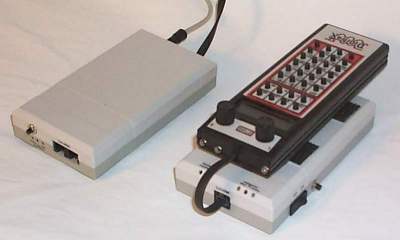
| Home Garden Railway Digital |  |
 [2003-03-07]
[2003-03-07]
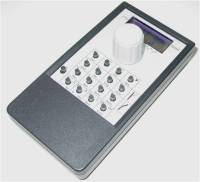 |
for Range up to 300m (900 ft) ! |
||
| North American readers PLEASE NOTE: |
|
Due to the DECT-modul being used the R/C Link is not suitable for use in Canada and USA. For all Non-European countries please check the applicable R/C regulations prior to purchasing one of the units. More informations about DECT could be found on DECTweb and Digital Enhanced Cordless Telecommunications. |
Not too long ago model railroaders, including those running garden railways, would do so from a more or less fixed position. The introduction of DCC brought large improvements. Using tethered throttles, as well as walk-around-control for the hand-helds allows for more mobility. However even long tethers or walk-arounds are still bothersome for large indoor layouts and garden railways, so it was quite obvious the solution would be some type of R/C adaptor.
"Why would you want to develop this?", was a question we, Matthias Manhart, Winterberg, Switzerland and a friend from Germany heard often in the past few month. Well, there is a simple answer: we really wanted a well functioning R/C controller for our model railroads.
The question was, what should this look like. The answer was relatively simple, the hand helds, which are already used with DCC systems are quite well designed and could/should be used. Matthias uses Digitrax and prefers the new DT400, my friend has a Lenz-System und likes the LH 200. Despite being completely different systems, there is one communality. Both handhelds use a rotary dial, which is the most common control method for model railroads. Not only that, but even the prototype (mostly in Europe) uses similar "handwheels" to select speed and braking steps in the locomotive cabs. We didn't even consider pushbuttons or similar "make do" solutions.
The most important and ultimate step was to get rid of the tether cable by replacing in with an R/C link.
The following was written with much enthusiasm, no surprise!, being as our evening "building project" exceeded all our expectations. And despite the occasional inquiries from our spouses as to who was married to whom!
Despite the easy formulation of the task, developing the actual R/C link was
the most time consuming part of the project. We decided to use tried and proven
industrial methods and components to assure error free performance. At the heart
of the R/C link is a DECT-modul which uses the same transmission technology
as the cordless phones. This modul can be used for secure data transmission.
In addition there are two micro-processors in conjunction with the required
software; all contained in an enclosure.

The processors are used to "fool" the handheld into believing it is communicating
with the central unit and to make the central unit believe it is communicating
with a handheld. Which commands are to be activated/carried out is transmitted
via the R/C link.. Using the DECT-protocol results in a link that is quick enough
to have no perceivable time lag.
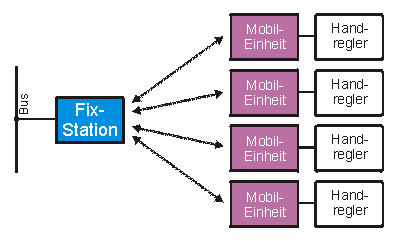
The portable enclosure (transmitter on RH side of picture underneath the handheld)
has a standard socket to connect one of the handhelds supplied for the respective
DCC system The receiver (LH side of picture) connects just like a handheld in
the usual manner to the central unit.

Being as we use two different DCC systems (Digitrax and Lenz) we developed an R/C link for each of the systems. The R/C link for the Digitrax system will also work with the Intellibox system from Uhlenbrock.
Using the R/C link is simplicity itself, there is only one power switch on the transmitter. This is the only function to be activated to use the link. Shortly after activation the handheld will be in "ready to use" mode. We consider this feature the biggest advantage of our implementation; no re-learning necessary as the handheld functions in exactly the same manner as if tethered with a cable.
The R/C link (just like a spec sheet):
| No re-learning of the controls, uses the same handheld as conventional operation. | |
| No licence for operation of radio apparatus required. DECT-moduls have a "General Application" licence and can be used on a "As required" basis. | |
| Useable, maximal distance for operation outside is approx. 300 meters (1000feet). For applications inside a structure it is approx 50 meters (165 feet). | |
| The R/C link uses bi-directional protocol which enables reading and display i.e. information of current speeds and position indication of turnouts. All engine addresses can be called up without restrictions. | |
| Any of the handhelds for the respective system can be used. We tested the Digitrax system using the DT100, DT300, DT400, LocoPalm and Uhlenbrock-Fred. The Lenz-System was tested with the LH 100, LH 200 and LH 30. We also tested the R/C link with Uhlenbrock's Intellibox being used as a central unit. | |
| "Programming on the Main" works without any problems | |
| Up to 4 R/C transmitters with handhelds can be used simultaneously with each receiver module. | |
| Rechargeable batteries are used for the transmitter, 2 cells give up to 5 hours of running time. 3 cells are good for approx 8 hours. Enough for a "long day" of operations. |
We tested the R/C links extensively and haven't experienced any glitches. As mentioned our expectations have been exceeded by far! In short, the R/C link works flawlessly!
We have noticed the following restrictions:
| When using FRED with Digitrax you need to repeat the sequence to hand-off an engine in order to make it active. | |
| Scrolling through the engine addresses with the Digitrax handhelds is slower than when connected by cable. | |
| Using the Lenz system you will not be able to access "programming on programming track". However "Programming on the Main" works in the usual fashion. |
The following picture shows the FRED handheld from Uhlenbrock connected to the transmitter. The transmitter could be attached to your belt.
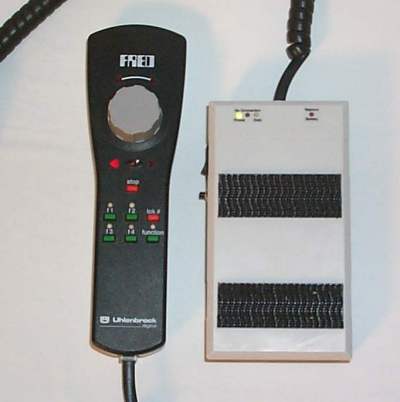
Digitrax's DT100 is slightly smaller than the transmitter. We attached it to the transmitter using Velcro.
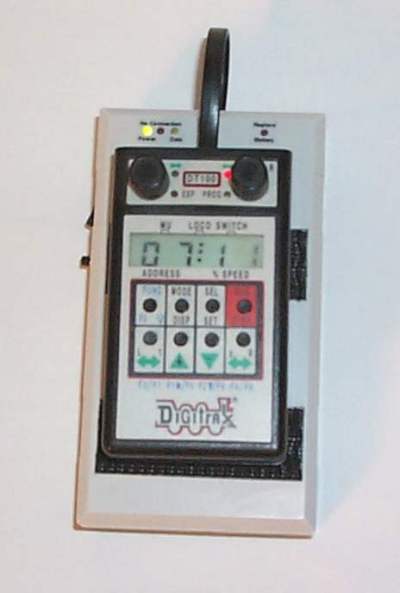
The R/C Link fulfills all expectations. The existing handhelds can be used, we don't need to make compromises in either functionality or user friendliness. The reach is sufficient even for larger garden railways and the reliabilty exceeds anything else that we have seen on the market up to now.
 [2003-03-07]
[2003-03-07]We developed a RC Trottle. This device replaces the mobile-unit.